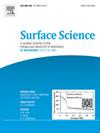Ce/CuO修饰TiO2(001)表面对VOCs吸附机理的密度泛函理论研究:甲苯和二氯甲烷的比较研究
IF 1.8
4区 化学
Q3 CHEMISTRY, PHYSICAL
引用次数: 0
摘要
甲苯和二氯甲烷作为工业废气中具有代表性的挥发性有机化合物(VOCs),已经引起了科学界的广泛关注。本研究采用密度泛函理论(DFT)研究了甲苯和二氯甲烷在原始锐钛矿tio_2(001)及其ce掺杂+ cuo掺杂表面上的吸附机理。结果表明,甲苯在tio2(001)表面发生稳定的化学吸附。Ce/TiO 2(001)和CuO/TiO 2(001)改性表面的吸附均显著增强,具有强电子转移和稳定成键的特点。甲苯分子在Ce/TiO2(001)底物上发生不稳定的结构变化,最终与底物原子形成强化学键,表明其吸附能力强,吸附能为-190.578 kJ/mol。二氯甲烷也表现出化学吸附,特别是在Ce/TiO 2(001)和氧桥CuO/TiO 2(001)表面,在那里它经历脱氯形成Cl和氯甲基自由基(ch2cl•)。这些自由基随后与表面形成稳定的化学键。二氯甲烷在Ce/ tio_2(001)上的高吸附能(-510.5 kJ/mol)证实了其强化学吸附作用。在热力学和动力学上,二氯甲烷的脱氯反应产生与Ce原子建立稳定化学键的游离Cl更有利。随后,ch2cl•发生氧化反应,释放出一个氢原子。本文章由计算机程序翻译,如有差异,请以英文原文为准。

Density functional theory insights to VOCs adsorption mechanism on Ce/CuO modified TiO2(001) surface: A comparative study on toluene and dichloromethane
Toluene and dichloromethane, as representative volatile organic compounds (VOCs) emissions from industrial exhaust gases, have attracted significant scientific attention. This study employs density functional theory (DFT) to investigate the adsorption mechanisms of toluene and dichloromethane on pristine anatase TiO₂(001) and its Ce-doped + CuO-doped surfaces. Results demonstrate that toluene undergoes stable chemisorption on the TiO₂(001) surface. Adsorption is significantly enhanced on both Ce/TiO₂(001) and CuO/TiO₂(001) modified surfaces, characterized by strong electron transfer and stable bonding. The toluene molecule undergoes unstable structural changes on the Ce/TiO2(001) substrate and eventually forms strong chemical bonds with the substrate atoms, indicating a strong adsorption capacity, with an adsorption energy of -190.578 kJ/mol. Dichloromethane also exhibits chemisorption, particularly on Ce/TiO₂(001) and oxygen-bridge CuO/TiO₂(001) surfaces, where it undergoes dechlorination to form Cl and chloromethyl radicals (CH₂Cl•). These radicals subsequently form stable chemical bonds with the surface. The high adsorption energy of dichloromethane on Ce/TiO₂(001) (-510.5 kJ/mol) confirms strong chemisorption. Dechlorination of dichloromethane, producing free Cl that establish stable chemical bonds with Ce atoms, is more advantageous both thermodynamically and kinetically. Subsequently, the CH₂Cl• undergoes an oxidation reaction, with a hydrogen atom being released.
求助全文
通过发布文献求助,成功后即可免费获取论文全文。
去求助
来源期刊

Surface Science
化学-物理:凝聚态物理
CiteScore
3.30
自引率
5.30%
发文量
137
审稿时长
25 days
期刊介绍:
Surface Science is devoted to elucidating the fundamental aspects of chemistry and physics occurring at a wide range of surfaces and interfaces and to disseminating this knowledge fast. The journal welcomes a broad spectrum of topics, including but not limited to:
• model systems (e.g. in Ultra High Vacuum) under well-controlled reactive conditions
• nanoscale science and engineering, including manipulation of matter at the atomic/molecular scale and assembly phenomena
• reactivity of surfaces as related to various applied areas including heterogeneous catalysis, chemistry at electrified interfaces, and semiconductors functionalization
• phenomena at interfaces relevant to energy storage and conversion, and fuels production and utilization
• surface reactivity for environmental protection and pollution remediation
• interactions at surfaces of soft matter, including polymers and biomaterials.
Both experimental and theoretical work, including modeling, is within the scope of the journal. Work published in Surface Science reaches a wide readership, from chemistry and physics to biology and materials science and engineering, providing an excellent forum for cross-fertilization of ideas and broad dissemination of scientific discoveries.
 求助内容:
求助内容: 应助结果提醒方式:
应助结果提醒方式:


